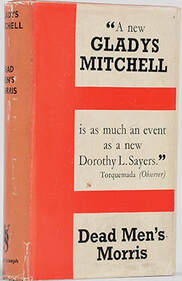
Joyka considers theme in Dead Men’s Morris and observes that “this book is all about lasting relationships. We finally get to meet “the family.” What better time than at Christmas and what better present than a huge boar’s head that takes three men to strap into the car?” Indeed, that opening scene does seem perfectly in keeping with Gladys Mitchell’s warm but strange sense of humour.
THE DANCERS
For me, nephew Carey Lestrange is drawn in an intriguing way that we haven’t often seen from Mrs. Bradley's friends and relations in the book series up to this point. From Joyka: “To be sure, he doesn’t sound all that attractive, with clothes looking like they have been slept in, nicotine-stained fingers, and paint-stained hands, but if Mrs. Bradley has both personal regard and respect for him, so then do I!”
Equally notable, Carey is allowed to show genuine physical and verbal affection for his saurian aunt, and that is rare to find in a Mrs. Bradley story. On several occasions, Mitchell describes Carey as taking the old woman in hand to aid her across the grounds or “placing his arm around her bony shoulders” in a bonhomous spirit. Carey’s loving attitude certainly adds to a slightly more human depiction of Mrs. Bradley, although I’m relieved to say that she still cackles harshly and can provide her relations with a display of knife-throwing when the mood strikes. (Catherine noticed this difference too; see her later comments.)
"Nay, us'll just let her be. Her can make her a bed where she will. 'Tis her 'ave to lie on it later," said Ditch, with heavy philosophy.
THE LANDSCAPE
I agree: Mitchell can be a wonderful evocator of mood and landscape – 1935's The Devil at Saxon Wall nearly traps the reader into becoming a prisoner of its darkly primeval setting – and the wet, muddy pastures and pathways of Dead Men’s Morris become noticeably tactile. The author’s love of county ordnance maps is on prominent display here, with Mrs. Bradley referencing them freely as she treks around the countryside with Carey in tow.
Martyn continues, “One of the joys of this novel so far is the contrast and clash of registers of speech – from the aristocratic polish of Sir Selby Villiers to the van man’s “‘Arf a mo, mate” and George’s occasional cockney (‘Some lout’s trick, sir. I’ll learn him if I lay my hands on him’); Pratt’s upper middle class prattle (‘One finds oneself well’) to all the oddities of Oxford pronunciation and dialect.”
THE DETECTIVE (AND THE CHAUFFEUR)
Catherine Dilts, whose own outdoors murder mystery Survive or Die I enjoyed and reviewed earlier this year, notes that Mrs. Bradley here “is drawn in a more pleasant light” than in other reading group stories. “Although the reptilian references remain, they seem gentler, and delivered in less frequent doses,” writes Catherine. She points to this wonderful line from Chapter Three:
"Well," said Mrs. Bradley, with the loving smile of a boa-constrictor which succeeds in engulfing its prey with the minimum of hazard, "and so this is Mr. Pratt!"
And Joyka’s well-chosen quotation from the inimitable detective can stand as the final word for this installment: “Murder is the applied mathematics of morbid psychology.”
Next time we pay a visit to Figure 2 and Shotover Simith (Chapters 7 to 12). The new post will appear on December 20. If anyone new wants to contribute, just send your comments by the evening of December 18 to [email protected] . Thanks to Joyka, Catherine, and Martyn for contributing!
 RSS Feed
RSS Feed